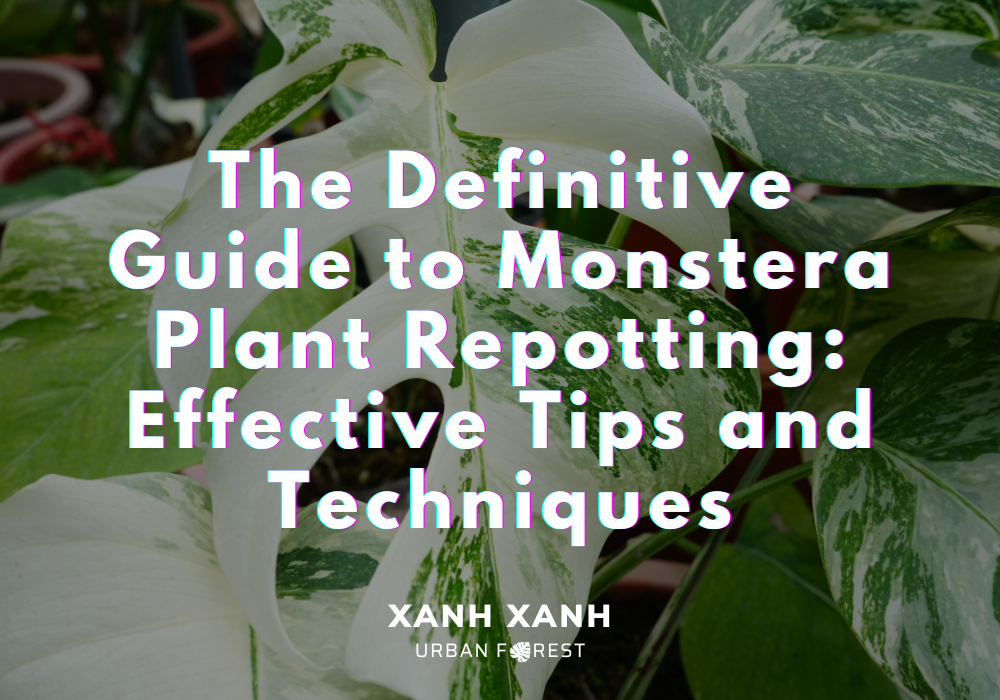Table of Contents
1. Introduction
Monstera plants are popular indoor plants cherished for their large, glossy leaves and unique leaf patterns. As these plants grow, they may outgrow their pots and require repotting to provide them with adequate space and nutrients for healthy growth. In this ultimate guide to Monstera plant repotting, we will explore the step-by-step process of repotting, essential tips and techniques, and answer frequently asked questions to ensure your Monstera thrives in its new home.



2. Why Repot Your Monstera Plant?
Repotting is necessary to provide your Monstera plant with sufficient space for root growth and access to essential nutrients. Over time, the original potting mix may become compacted, leading to poor drainage and reduced soil quality. Repotting allows you to refresh the soil, promote healthier root growth, and prevent rootbound conditions.
3. Signs Your Monstera Plant Needs Repotting
- Roots growing out of the drainage holes
- Slow growth or stunted development
- Wilting or yellowing leaves
- Frequent waterlogging or dryness
- Excessive root growth tangling around the pot
4. Choosing the Right Time for Repotting
The ideal time to repot your Monstera is during its active growing season, which typically occurs in spring or early summer. Avoid repotting during the winter months when the plant enters a dormant phase.
5. Selecting the Perfect Pot
When selecting a new pot for your Monstera, consider choosing one that is one or two sizes larger than its current pot. Opt for a pot with drainage holes to prevent waterlogging. Additionally, choose a pot material that promotes airflow to the roots, such as terracotta or porous containers.
6. Preparing the Potting Mix
Create a well-draining potting mix suitable for Monstera plants by combining equal parts of peat moss, perlite, and potting soil. This mixture provides adequate drainage, retains moisture, and offers essential nutrients for your plant’s growth.
7. Preparing Your Monstera for Repotting
To prepare your Monstera plant for repotting, water it thoroughly a day or two before the repotting process. Moist soil makes it easier to remove the plant from its current pot without damaging the roots.

8. Gently Removing the Plant from Its Current Pot
Carefully slide this plant out of its current pot by gently tapping the sides or squeezing it. If the plant is stubbornly stuck, run a knife along the inner edges to loosen the roots.
9. Inspecting the Root System
Upon removing the Monstera from its pot, inspect the root system for any signs of damage, discoloration, or pest infestation. Healthy roots should be firm, white, and spread evenly throughout the root ball.
10. Pruning Overgrown Roots
If you notice tangled or overgrown roots, it’s essential to trim them before repotting. Use clean, sharp scissors or pruning shears to remove any damaged or excessively long roots. Pruning stimulates new root growth and prevents the plant from becoming rootbound.
11. Placing Your Monstera in the New Pot
Position your Monstera plant in the center of the new pot, ensuring it sits at the same depth as it did in the previous pot. Adjust the plant’s position, adding or removing potting mix, if necessary, to achieve the desired height.
12. Filling the Pot with Fresh Potting Mix
Gently fill the space around the Monstera‘s roots with the prepared potting mix. Lightly press the mix to eliminate any air pockets. Leave a small gap between the soil surface and the rim of the pot to prevent water overflow.
13. Watering and Post-repotting Care
After repotting, thoroughly water the Monstera until water drains out of the pot’s drainage holes. Keep the plant in a warm, well-lit area but avoid direct sunlight for a few days to allow it to recover from the repotting process. Maintain regular watering and provide appropriate lighting conditions to support the plant’s recovery.
14. Common Mistakes to Avoid
- Repotting too frequently
- Using a pot that is too large
- Neglecting to water or overwatering
- Using poor-quality or incorrect potting mix
- Exposing the plant to direct sunlight immediately after repotting
15. FAQs
- How often should I repot my Monstera plant?
It is generally recommended to repot your Monstera every 1-2 years or when you notice signs of rootbound conditions.
- Can I use a decorative pot without drainage holes?
While decorative pots without drainage holes can be used, it is crucial to ensure proper drainage by placing a layer of rocks or pebbles at the bottom and monitoring water levels carefully.
- Should I prune my Monstera before repotting?
Pruning your Monstera before repotting can help manage the plant’s size and promote healthy growth. Trim any excessively long or damaged roots and consider pruning the foliage if necessary.
- Can I use garden soil for repotting my Monstera?
Garden soil is generally not recommended for repotting Monstera plants as it tends to be heavy and can lead to poor drainage. It is best to use a well-draining potting mix specifically formulated for indoor plants.
- How long does it take for a repotted Monstera to recover?
After repotting, it may take a few weeks for the Monstera to recover and adjust to its new pot. Ensure proper care, including adequate watering and appropriate lighting, to support its recovery.
16. Conclusion
Repotting your Monstera plant is a vital aspect of its care routine, ensuring its health and vitality. By following the guidelines and tips provided in this ultimate guide, you can successfully repot your Monstera and provide it with the best conditions to flourish in its new home. Remember to be patient and attentive to your plant’s needs, and enjoy the beauty of a thriving Monstera in your living space.
If you have any questions, you can contact us via:
- Instagram: Xanh Xanh Urban Forest
- Facebook: Xanh Xanh Urban Forest

